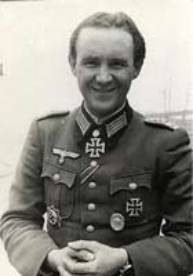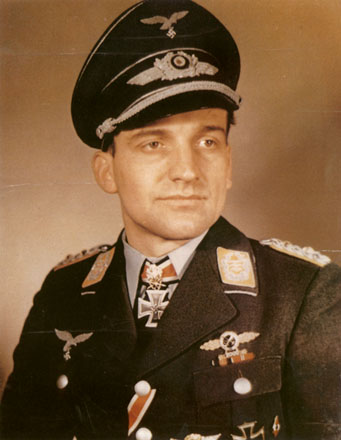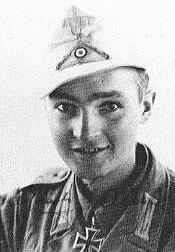Hello Gentlemen IV
Apart from the many members of the Wehrmacht’s traditional branches and of the Waffen-SS that recieved the Knight’s Cross, there where also members of some more obscure/neglected branches that contributed to the war effort and subsequently where decorated with Germany’s highest award. The men of Germany’s Fire brigades are such examples of unsung heroes that also had the very dangerous job of disarming and disposing unexploded bombs, Blindgänger.
The following men and officers, die Feuerwerker, where decorated with the Knight’s Cross:
Egon Agtha, RK on 03.02.1945 as Oberleutnat (W) d. R. Führer eines Sprengkommando im Luftgau III Berlin. Aghta received the Oakleaves (no. 778) on 12.03.1945 as a Hauptmann d. R. while holding the same command.
Karl Kudla, RK on 18.04.45 as Oberfeldwebel (W), Feuerwerker eines Sprengkommando in Berlin/Luftgau-Kommando III.
Siegfried Rieger, RK on 18.04.1945 as Oberfeldwebel (Heer), Sprengkommando der Luftwaffe I/III im Luftgaukommando Berlin.
Heinz Schweizer, RK on 28.06.1943 as Hauptmann (W) (Kr.O.) Führer Spreng-Kommando der Luftwaffe I/IV Ratingen/Düsseldorf.
Karl-Anton Thomas, RK on 21.04.1945 as Oberfeuerwerker im Sprengkommando der Luftwaffe 2./VI.
There where also two men who recieved the Knight’s Cross for doing this dangerous job without any formal Feuerwerker education or position, namely:
Jacob Hoffend, RK on 07.02.1945 as NSDAP-Ortsgruppenleiter (ehrenamtl.) in Köln for disposing of 1892 Blindgänger bombs.
Wilhelm Sitt, RK on 07.02.1945 as Führer eines Btls. D. Kölner Volksturmes und Abschnittsleiter (ehrenamtl.) im Gau-Org. Amt der NSDAP-Gauleitung Köln-Aachen. He disposed of several hundreds of Blindgänger bombs.
Source for the above listed men: Veit Scherzer “Ritterkreuzträger 1939-1945” (2005).
So, after a rather long intro, here’s the story of Eichenlaubenträger
Hauptmann (W) d. R. Egon Agtha, the highest decorated Feuerwerker in WWII. Egon August Agtha was born on January 20, 1918 in Berlin. After completing his six months in the RAD, Agtha joined the Heer in November 1938 and was placed in the I./Artillerie-Regiment 3 (part of 3. Infanterie-Division) in Frankfurt a. d. Oder. After participating in the war against Poland, Agtha left the Regiment as a Gefreiter in October 1939. He then volunteered for the Kriegs-Feuerwerker-Lehrgang 39/I at the Heeres-Feuerwerkerschule in Berlin- Lichterfelde. Egon Agtha became a Gefreiter in Feuerwerkerdienst in January 1940 and then immediately a Unteroffizier in February. After a short service in Kaiserslauten was he placed back in Berlin in the Sprengkommando der Luftwaffe 1./III in 1940.
Unteroffizier im Feuerwerkerdienst Egon Agtha was severly wounded on September 16, 1941 in the Sachsenhausen area north of Berlin, when he was disarming Blindgänger bombs from a RAF attack the previous wee. One of the Blindgänger bombs spontaneously exploded and Agtha received serious injuries to his face and head, resulting in partial eyesight damage. After a long hospitalization (where one of the doctors he met was his wife-to-be Barbara), Agtha received the Wound Badge in Silver and the Iron Cross, 2nd Class on December 14, 1941 (this for disarming 30 enemy Blindgänger bombs). As the military authorities wanted to dismiss him because of his wounds, Agtha used his Feuerwerker education and experience to remain in duty as a civilian Feuerwerker Officer in Wehrmacht, (W) Offizier des Waffenwesens. Egon Agtha received Wound Badge in Gold on Jaunary 16, 1943 and Iron Cross,1st Class on June 18, 1943 for his work as a Feuerwerker. He finally received a promotion to Leutnant (W) in October the same year.
After partly working as an instructor at the Heeres-Feuerwerkerschule I in Berlin in 1942 and 1943, Egon Agtha returned to the Sprengkommando 1/III der Luftwafe in Berlin on April 1, 1943. From then on, Agtha and his fellow Feuerwerker worked almost daily with the thousands of RAF and USAAF Blindgänger bombs that rained down on Greater Berlin. Leutnant (W) d. R. Egon Agtha received the German Cross in Gold on January 19, 1945 for his, and his Sprengkmmando’s relentless and dangerous job. On February 3, 1945 Agtha received the Knight’s Cross from Adolf Hitler in person for his “vorbildliche Tapferkeit und für sein unerschrockenes Verhalten beim Vernichten von feindlichen Langzeitzündern” and a promotion to Oberleutnant (W) d. R. On March 12, 1945 Egon Agtha recieved the Oakleaves to his Knight’s Cross (as no. 778) and a promotion to Hauptmann (W) d. R. in recognition of his both very dangerous and very important work in the Reich’s Capital.
When the battle for Berlin started in April 1945, Hauptmann (W) d. R. Egon Agtha and his Sprengkommando was inevitably drawn into the intense defence and combat against the Soviet Red Army. On April 24, the entire Sprengkommando was divided into three groups. No. 1 was assigned to the Volksturm, no. 2 was assigned as a Stoss-Trupp and armed with Panzerfäuste and no. 3 was assigned as a Brückenkommando ready to blow up the bridges over the Spree. The personel and the cadets from the Heeres-Feuerwerkerschule I was divided into two companies and became part of an Alarm-Bataillon under the command of Major (W) Wolfgang Skorning under the designation II./Festungs-Regiment 60. This unit saw heavy combat and received quite a lot of casualties in the following battle.
Hauptmann (W) d. R. Egon Agtha commanded the Panzerjäger group armed with Panzerfäuste and apparently saw a great deal of combat. On May 1, Aghta released his few remaining Feuerwerker soldiers from their oath of loyalty and the group tried to escape out of Berlin. Due to his poor eyesight, Agtha got separated from the group and together with one comrade, Böhm, tried to escape via the S-Bahn and the U-Bahn from Tiergarten to the Reichsportfeld. They reached Spandau in the morning of May 2, and tried to cross a bridge, the Charlottenbrücke where a german Flakvierling engaged the Soviet units. During a brief pause in the firing, Agtha tried to dash over the bridge but fell with a shot through his throat and Böhm was shot in the arm. Despite of his wound, Böhm managed to drag Agtha’s dead body and buried it in the Stresowplatz near the Charlottenbrücke. Thus ended the life of Germany’s most decorated Feuerwerker, Hauptmann (W) d. R. Egon Agtha. He fell in the town where he was born and had lived and served nearly his entire life.
Source for this mini-biography of Egon Agtha is the book by Wolfgang Thamm, “Hauptmann (W) Träger des Ritterkreuzes des Eisernen Kreuzes mit Eichenlaub Egon August Agtha – Feuerwerker und Sprengkommadoführer” (2005). This is a very interesting little book, especially if you are interested in Berlin during the war. Recommended. It can be found at
http://www.cimm.de and as always, eventual wrongful facts or mistakes are mine alone, as is the recapitulation and translation.
Hauptmann (W) d. R. Egon Agtha
 http://www.lexikon-der-wehrmacht.de
http://www.lexikon-der-wehrmacht.de
I hope that more members will share their favorite Knight's Cross action so that this thread develops even further. There is about 7.300 aspects of this phenomenon...

Regards,
Krollspell




